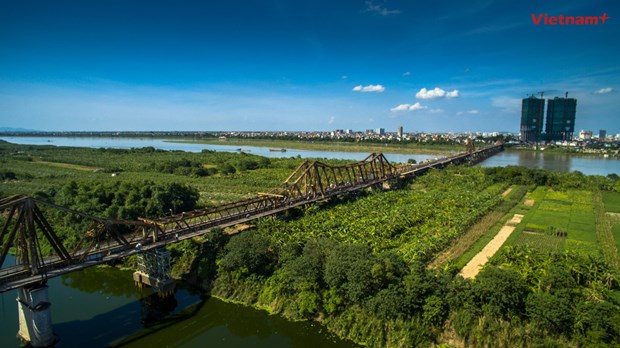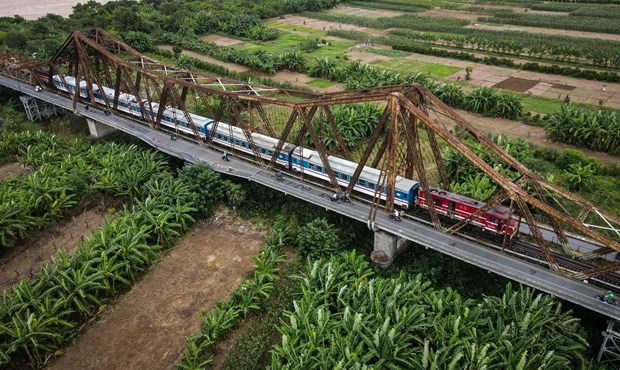Peaceful Long Bien bridge amidst bustling capital city
 Long Bien, the first steel bridge spanning Red River, connects Hoan Kiem and Long Bien districts of Hanoi (Photo: VietnamPlus)
Long Bien, the first steel bridge spanning Red River, connects Hoan Kiem and Long Bien districts of Hanoi (Photo: VietnamPlus)Hanoi (VNA) – Long Bien, an iconic bridge of Hanoi, has turned 120, becoming not only a great witness of the history but also a favourite destination for locals and visitors who wish to enjoy peace amid a bustling city.
For generations of Hanoians, the iconic bridge spanning the Red River has become synonymous with their everyday life.
Witness of history
Spanning three centuries, Long Bien Bridge witnessed many ups and downs of Hanoi as well as the capital city’s rise throughout the history. The bridge carries in itself the city’s historical, cultural and social values.
On September 13, 1889, the Governor-General of France in Indochina held a groundbreaking ceremony for a bridge crossing the Hong (Red) River. Its construction area was chosen to be the spot from which the French ship opened fire at Quan Chuong and Bac (Northern) Gates - entrances to the capital city.
The bridge was designed in the style of the keys that the French contractor Daydé & Pillé Company applied for the first time to Tolbiac Bridge in Paris. It has a length of 1,862m, consisting of 19 steel beams and a stone path. There is a single railroad track for trains in the middle and both sides have pathways for motorised vehicles and pedestrians.
The steel bridge was the fourth-largest and the second-longest of its kind in the world at the time, after the Brooklyn Bridge in the US.
It was officially inaugurated on February 28, 1902, after nearly three years of construction, and named after Paul Doumer - the French Governor-General of Indochina. After the liberation of the capital city in 1954, it was renamed Long Bien.
The construction of the first steel bridge in Vietnam took the efforts of thousands of Vietnamese workers under the guidance of French experts. In addition to tonnes of limestone transported from Thua Thien-Hue, 30,000 cubic metres of stone and ironwood blocks were brought from Thanh Hoa and tonnes of cement from Hai Phong.
Vietnamese workers also created tens of thousands of rivets needed for the bridge and dived deep into the river to construct its abutment, 30m below the water surface.
According to Architect Dao Ngoc Nghiem, former director-general of the Hanoi Department of Planning and Architecture, Long Bien Bridge was imbued with national identity even though it was a modern architectural heritage at that time, as the French gave it the shape that resembles a dragon flying over the Red River, which is associated with the cultural symbol of Hanoi
Over the time, the bridge has stood to assist the people of the capital during resistance wars against the French and Americans, becoming a symbolic part of Vietnamese history.
During the war, it was bombed 14 times. Its nine spans and four piers were damaged but immediately repaired and preserved to ensure traffic, and important shipments could continue to support the southern battlefields.
Must-visit destination
With its unique nostalgic appearance, Long Bien Bridge has become a tourist attraction of Hanoi and a must-see place for tourists in the capital city.
 A bird view of Long Bien (Photo: VNA)
A bird view of Long Bien (Photo: VNA)Visiting the bridge at any time in the day and any season in the year, visitors can feel a contemplative beauty of time.
Though many modern and grand bridges have been built crossing the Red River, Long Bien Bridge has never lost its place in Hanoians’ heart.
Every morning, long lines of street vendors, workers or students can be seen travelling back and forth on the bridge, just as they have been doing for over a century.
Teenagers, expats and tourists alike love to walk across it on the weekend, buying boiled corn or charcoal-grilled sweet potatoes.
Long Bien is still considered one of the most beautiful bridges in Hanoi, thanks to its unique nostalgic appearance.
Standing on the bridge, visitors can have the best view of sunrise or sunset in the city. Many couples also choose it as the backdrop for their wedding photos. Foreign visitors like to stroll along the bridge to enjoy the fresh air, and catch a panoramic view of the city.
Through the past 120 years, the values of the past are still deposited on each span of the bridge. Despite many changes of the country and city, the symbolic value of Long Bien Bridge remains unchanged. The beauty and historical values of the bridge, which connects the past and the present, has become cultural heritage of the capital city./.













